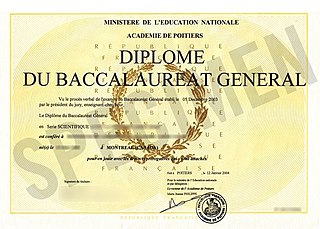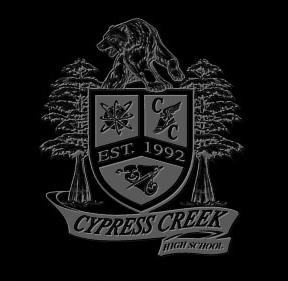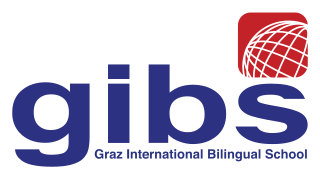
An essay is, generally, a piece of writing that gives the author's own argument, but the definition is vague, overlapping with those of a letter, a paper, an article, a pamphlet, and a short story. Essays have been sub-classified as formal and informal: formal essays are characterized by "serious purpose, dignity, logical organization, length," whereas the informal essay is characterized by "the personal element, humor, graceful style, rambling structure, unconventionality or novelty of theme," etc.

Matura or its translated terms is a Latin name for the secondary school exit exam or "maturity diploma" in various European countries, including Albania, Austria, Bosnia and Herzegovina, Bulgaria, Croatia, Czech Republic, Hungary, Italy, Kosovo, Liechtenstein, Montenegro, North Macedonia, Poland, Serbia, Slovakia, Slovenia, Switzerland and Ukraine.

The baccalauréat, often known in France colloquially as the bac, is a French national academic qualification that students can obtain at the completion of their secondary education by meeting certain requirements. Though it has only existed in its present form as a school-leaving examination since Emperor Napoleon Bonaparte's implementation on March 17, 1808, its origins date back to the first medieval French universities. According to French law, the baccalaureate is the first academic degree, though it grants the completion of secondary education. Historically, the baccalaureate is administratively supervised by full professors at universities.
The Hong Kong Advanced Level Examination, or more commonly known as the A-level, conducted by the Hong Kong Examinations and Assessment Authority (HKEAA), was taken by senior students at the end of their matriculation in Hong Kong between 1979 and 2012. It was originally the entrance examination in University of Hong Kong until the introduction of the Joint University Programmes Admissions System (JUPAS) in 1992, which made it the major university entrance examination until academic year 2011/2012.
Literae humaniores, nicknamed Greats, is an undergraduate course focused on classics at the University of Oxford and some other universities. The Latin name means literally "more human literature" and was in contrast to the other main field of study when the university began, i.e. res divinae, also known as theology. Lit. hum., is concerned with human learning, and lit. div. with learning treating of God. In its early days, it encompassed mathematics and natural sciences as well. It is an archetypal humanities course.
The International Baccalaureate Diploma Programme (IBDP) is a two-year educational programme primarily aimed at 16-to-19-year-olds in 140 countries around the world. The programme provides an internationally accepted qualification for entry into higher education and is recognized by many universities worldwide. It was developed in the early-to-mid-1960s in Geneva, Switzerland, by a group of international educators. After a six-year pilot programme that ended in 1975, a bilingual diploma was established.
The Group 3: Individuals and societies subjects of the IB Diploma Programme consist of ten courses offered at both the Standard level (SL) and Higher level (HL): Business Management, Economics, Geography, Global Politics, History, Information technology in a global society (ITGS), Philosophy, Psychology, Social and cultural anthropology, and World religions. There is also a transdisciplinary course, Environmental systems and societies, that satisfies Diploma requirements for Groups 3 and 4.
The Group 2: Language acquisition subjects of the IB Diploma Programme consist of the nearly 80 additional languages offered and may be studied at the following levels: B, or ab initio. Latin and Classical Greek are also offered and may be taken at SL or HL. To earn an IB Diploma, a candidate must study an additional language, though a second Language A may be taken instead of studying that language as a Group 2 subject.
The Group 4: Sciences subjects of the International Baccalaureate Diploma Programme comprise the main scientific emphasis of this internationally recognized high school programme. They consist of seven courses, six of which are offered at both the Standard Level (SL) and Higher Level (HL): Chemistry, Biology, Physics, Design Technology, and, as of August 2024, Computer Science is offered as part of the Group 4 subjects. There are also two SL only courses: a transdisciplinary course, Environmental Systems and Societies, that satisfies Diploma requirements for Groups 3 and 4, and Sports, Exercise and Health Science. Astronomy also exists as a school-based syllabus. Students taking two or more Group 4 subjects may combine any of the aforementioned.
The Group 6: The Arts subjects of the International Baccalaureate Diploma Programme consist of five courses at both Standard Level (SL) and Higher Level (HL): Dance, Music, Theatre, Visual Arts, and Film. The transdisciplinary course Literature and Performance is also available at Standard Level. Students seeking the IB Diploma may substitute courses from the other five Subject Groups instead of taking a Group 6 course. A school-based syllabus devised by an IB World School, as approved and externally moderated by the IB, may also form the basis for a course taken in place of a Group 6 course.

The Toronto French School (TFS), founded in 1962, is an independent, bilingual, co-educational, non-denominational school in Toronto, Ontario, Canada. Charles III, as King of Canada, is the royal patron of the school. The school rebranded in 2011 to become TFS – Canada's International School.
Irish is a subject of the Junior Cycle examination in Secondary schools in Ireland. There are three levels: Higher, Ordinary and Foundation.
The Singapore-Cambridge General Certificate of Education Ordinary Level is a GCE Ordinary Level examination held annually in Singapore and is jointly conducted by the Ministry of Education (MOE), Singapore Examinations and Assessment Board (SEAB) and the University of Cambridge Local Examinations Syndicate (UCLES). Students are graded in the bands ranging from A to F and each band has a respective grade point, a lower grade point indicates poor performance. The number at the end of each grade corresponds to the grade point that they receive. To pass an individual O-Level subject, a student must score at least C6 or above. The highest grade a student can attain is A1.

Penilaian Menengah Rendah was a Malaysian public examination targeting Malaysian adolescents and young adults between the ages of 13 and 30 years taken by all Form Three high school and college students in both government and private schools throughout the country from independence in 1957 to 2013. It was formerly known as Sijil Rendah Pelajaran. It was set and examined by the Malaysian Examinations Syndicate, an agency under the Ministry of Education.
DELTA is an English language teaching (ELT) qualification for experienced Teachers of English as a Foreign Language (TEFL) and Teachers of English to Speakers of Other Languages (TESOL). It is provided by Cambridge English Language Assessment through authorised Cambridge English Teaching Qualification centres and can be taken either full-time or part-time. The full name of the course was originally the Diploma in English Language Teaching to Adults and is still referred to in this way by some course providers. However, in 2011 the qualification title was amended on the Ofqual register to the Cambridge English Level 7 Diploma In Teaching English to Speakers of Other Languages (DELTA) in order to reflect that the wider range of students that teachers might have, including younger learners.

Cypress Creek High School is located in Orlando, Florida, and serves students in grades 9 through 12.
C2 Proficiency, previously known as Cambridge English: Proficiency and the Certificate of Proficiency in English (CPE), is an English language examination provided by Cambridge Assessment English (previously known as Cambridge English Language Assessment and University of Cambridge ESOL examination).
English is the only compulsory subject for the award of the Higher School Certificate at the end of secondary schooling in New South Wales, Australia. Marks gained in at least two units of English must also be included in the calculation of the Australian Tertiary Admission Rank (ATAR) used to determine entry to university. Students must study one of the following courses:

The Graz International Bilingual School (GIBS) is an Austrian bilingual (English/German) university preparatory semi-independent charter school Gymnasium in Graz, Austria. The school mainly focuses on languages, offering German, English, Russian, Latin, French and Spanish. Students graduate with the Austrian Matura, the IB Diploma or with both, assuming that they meet the criteria necessary.

Ritsumeikan Uji Junior and Senior High School (立命館宇治中学校・高等学校) is a private school located in the city of Uji south of Kyoto, Japan. The high school opened in 1994 and the middle school opened in 2003. It is currently one of four junior and senior high schools affiliated with Ritsumeikan University. The Ritsumeikan family of schools also includes Ritsumeikan Asia Pacific University, located in Beppu, and Ritsumeikan Primary School, located in north Kyoto.






